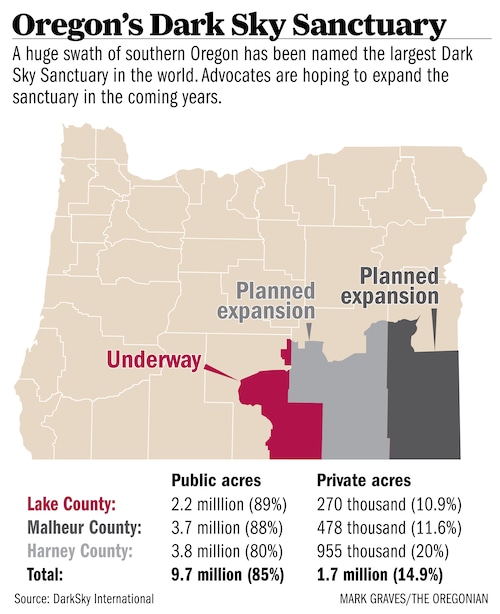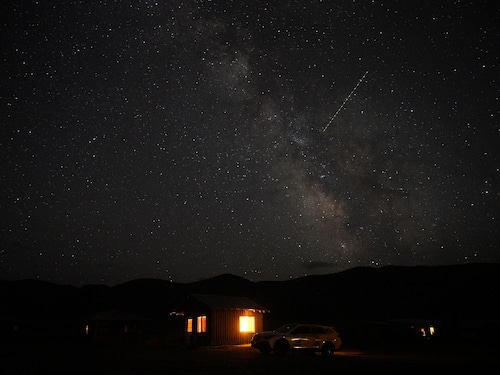A 2.5 million-acre swath of southern Oregon has been named the largest Dark Sky Sanctuary in the world.
The region, which on Monday was officially named the Oregon Outback International Dark Sky Sanctuary, comprises the southeastern half of Lake County, including Hart Mountain, Lake Abert and Summer Lake. Future plans include expanding the sanctuary to 11.4 million acres across Harney and Malheur counties.
The designation was given by DarkSky International, an organization dedicated to protecting the nighttime environment and preserving dark skies through environmentally responsible outdoor lighting. The project is the work of the Oregon Dark Sky Network, an ad-hoc group of state, local and federal officials, private individuals, business owners and tourism agencies.
Travel Southern Oregon, which is a member of the network, celebrated the designation in a news release Monday.
“This four-year collaboration brings together so many of the elements we try to achieve in regenerative tourism,” Bob Hackett, executive director of Travel Southern Oregon, said. “It not only elevates the destination experience for visitors to Lake County and opens up opportunities for local businesses, but it also helps agencies and residents steward their lands in ways that celebrate a legacy of starry night skies for generations to come.”
Oregon already has two destinations with official DarkSky International designations: Prineville Reservoir State Park, which in 2021 became a Dark Sky Park, and Sunriver Nature Center & Observatory, which was named a Dark Sky Place in 2020.

Oregon Dark Sky Sanctuary map.Mark Graves/The Oregonian
The Oregon Outback International Dark Sky Sanctuary is now the largest of 19 Dark Sky Sanctuaries, which are spread out across five continents. At 2.5 million acres, the Oregon sanctuary is larger than Minnesota’s 1 million-acre Boundary Waters Canoe Area Wilderness, which was designated as a Dark Sky Sanctuary in 2020.
The expansion of the Oregon Outback International Dark Sky Sanctuary seems inevitable, with only a few local approvals and lighting changes needed to make it happen, DarkSky International said. Most land in the region is either privately property or public lands managed by the Bureau of Land Management. The largest city in the area is Lakeview, home to fewer than 2,500 people.
Stargazers know southern and southeast Oregon as home to some of the best places to watch meteor showers and other astronomical events. Dark, clear skies are ideal for anyone hoping to peer into the cosmos, whether with a telescope or the naked eye.
Amber Harrison, program manager for DarkSky International, said in a news release Monday that the organization is already looking forward to the second phase of the Oregon Outback project, the big expansion, which would be the first landscape-scale sanctuary of its kind.
“Congratulations to the Oregon Outback Dark Sky Network team for achieving a monumental milestone in our journey towards preserving the night,” Harrison said. “Your dedication and collaboration have made Phase 1 of the Oregon Outback International Dark Sky Sanctuary a reality, showcasing the power of collective action in safeguarding night sky protections.”
Stargazing
--Jamie Hale covers travel and the outdoors and co-hosts the Peak Northwest podcast. Reach him at 503-294-4077, jhale@oregonian.com or @HaleJamesB.
Our journalism needs your support. Subscribe today to OregonLive.com.
